Seeing your child trying to catch a lizard in the yard or your cat brings in a lizard gift for you, you may be wondering what lizard it is. There are 16 lizards you may come across in Alabama, whether at your home or you see one when out walking. Continue reading for full details on the lizards in Alabama.
Are There Poisonous Lizards in Alabama?
The good news is that none of the lizards in Alabama are poisonous, but it’s important to note that lizards carry Salmonella.
If you or your child touches or handles one of these reptiles, ensure you wash hands thoroughly and do not touch your mouth until hands are washed, reducing the risk of being infected with Salmonella.
Lizards in Alabama
The 16 lizards in Alabama that you may come across include:
1. Eastern Slender Glass Lizard

Scientific name: Ophisaurus attenuatus ssp. longicaudus.
Common name: Eastern slender glass lizard.
The eastern slender glass lizard has a brown to yellow body with six stripes and white specks in the middle of its scales.
These lizards can grow up to between 22 and 36 inches (0.56m to 0.91m) in total length (including the tail). The tail makes up two thirds of the total body length.
They have stiff, hard bodies with a pointed snout. Females are similar in size to males, but their markings tend to fade as they age.
These glass lizards have ears and eyelids, unlike snakes, but they also don’t have belly plates that snakes have, which means they struggle to move across smooth surfaces with their legless bodies.
These lizards prefer old fields, woodlands, and prairies and can often be found close to a water source. You may also spot an eastern slender glass lizard in pine forests and debris.
2. Mimic Glass Lizard

Scientific name: Ophisaurus Mimicus.
Common name: Mimic glass lizard, rainbow glass lizard.
The mimic glass lizard is a long, limbless and slender lizard that looks very much like a snake. These lizards have a lateral fold down each side of their bodies with ear openings movable eyelids. Their scales have body plates which make their bodies stiff.
These are the smallest of the glass lizards in Alabama. They grow up to 7.1 inches (18cm) from snout to vent. Once you include the tail, these glass lizards can grow up to 11.7 inches (30cm). The tail makes up two thirds of their full length.
The tail of the mimic glass lizard is very fragile and they can break them if threatened, giving them time to escape from predators.

The mimic glass lizard is a brown to tan color that may have dark or light speckling or both. They have a mid-dorsal stripe along the body and most of their tails but note this stripe may be faint.
They have lateral stripes, that are narrow, on their tails, and above the fold of the back of the body. Some have vertical bars which can be seen on their necks and their tummies are pale.
These lizards can be found in savannas, flat woods, bogs, and more. They like tall grass as ground cover and you will find them close to a water source.
3. Eastern Glass Lizard
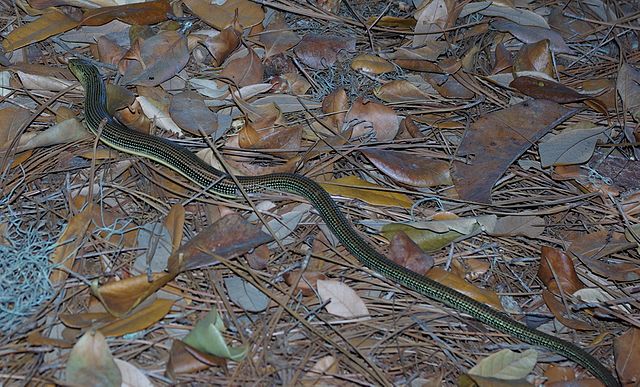
Scientific name: Ophisaurus ventralis.
Common name: Eastern glass lizard.
The eastern glass lizard can grow up to forty three inches (108cm) in total length with a snout to vent length of 12 inches (30.5cm). The tail makes up the majority of the body.
They have over ninety scales on their lateral groove with no dark stripes below the lateral groove. They also don’t have any mid-dorsal stripe, but the neck does have vertical white marks, along with the posterior corners of their scales.
Older eastern glass lizards take on a green color above and yellow on their tummies. Juveniles tend to be khaki in color with two stripes running down their backs.

These legless lizards can be found throughout the United States from Virginia to Oklahoma and south Florida to Missouri.
4. Indo-Pacific Gecko
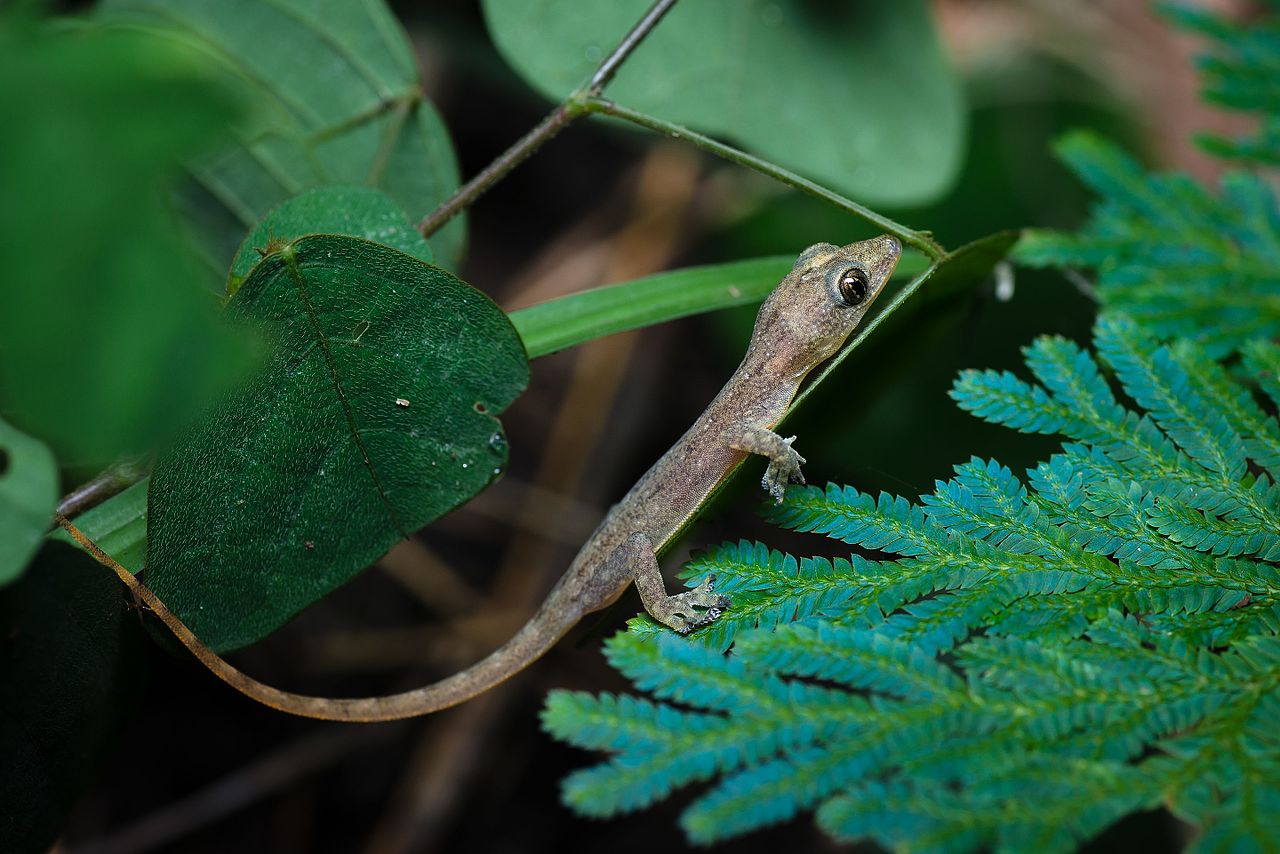
Scientific name: Hemidactylus Garnotii.
Common name: Indo-Pacific gecko, Garnot’s house gecko, fox gecko, Assam greyish brown gecko.
The Indo-pacific gecko has a pointed snout with a concave forehead and rounded ear openings.
There is a slight fold that can be seen on the skin along the flank, along with another fold near the hind limbs. Their throats are covered with small granular scales with moderate tummy scales. They have flat tails with a sharp lateral edge with small scales on the upper surface.
They are uniformly brown/gray in color with brown to white spots and a white belly.
They grow up to 2.6 inches (6.6cm) from snout to vent, excluding their tails.
5. Mediterranean House Gecko

Scientific name: Hemidactylus Turcicus.
Common name: Mediterranean house gecko.
The Mediterranean house gecko has a rounded snout with a concave forehead and oval ear openings. They have cylindrical tails, which are covered in thin scales.
They are light brown to gray in color with darker spots and white undersides. Often, they look translucent, except for some of their spots. These geckos can be on their own or in groups of two to five.
The Mediterranean house gecko grows up to five inches (13cm) from snout to tail.
6. Green Anole

Scientific name: Anolis carolinensis.
Common name: Green anole, Carolina anole, Carolina green anole, American anole, American green anole, North American green anole, red-throated anole, American chameleon.
The green anole is a medium-sized lizard that has a slender body with a long head. They have adhesive pads, which help them to climb. The green and brown anole are popular pet anole in the market.
Males are larger than the females with a large dewlap, which is right red. Females have a smaller dewlap that is light in color, often ranging from white to pale pink. The female can be distinguished with a white stripe that runs down her back.
These lizards can grow up to eight inches in length (20.3cm). Up to seventy percent of this size is their tail, with bodies only reaching three inches (7.5cm).
These are ground-dwelling lizards often found amongst shrubs. It’s not uncommon to see them in urban areas, often along the edge of forests, they prefer brush and forests.
7. Brown Anole

Scientific name: Anolis Sagrei.
Common name: Brown anole lizard, Cuban brown anole, De la Sagra’s anole.
The brown anole is light brown with dark brown to black markings on their backs. They also have light brown coloration on their sides with yellow to orange-red dewlaps.
Males grow up to 8 inches (20.3cm), while females remain slightly smaller, growing up to 5.9 inches (15cm) in length.
They have a ridge which travels from the tail to behind the head. Females are easily identifiable with a light brown stripe running all the way down their spine.
8. Texas Horned Lizard

Scientific name: Phrynosoma Cornutum.
Common name: Texas horned lizard.
The Texas horned lizard is often called the horned toad or horned frog, due to its rounded body and flat snout. Their horns are extensions of their craniums.
This is the largest of the fourteen horned lizard species in the United States growing up to 2.7 inches (69mm) from snout to vent with females being larger than the males sometimes growing up to 4.5 inches (11.4cm).
9. Eastern Fence Lizard
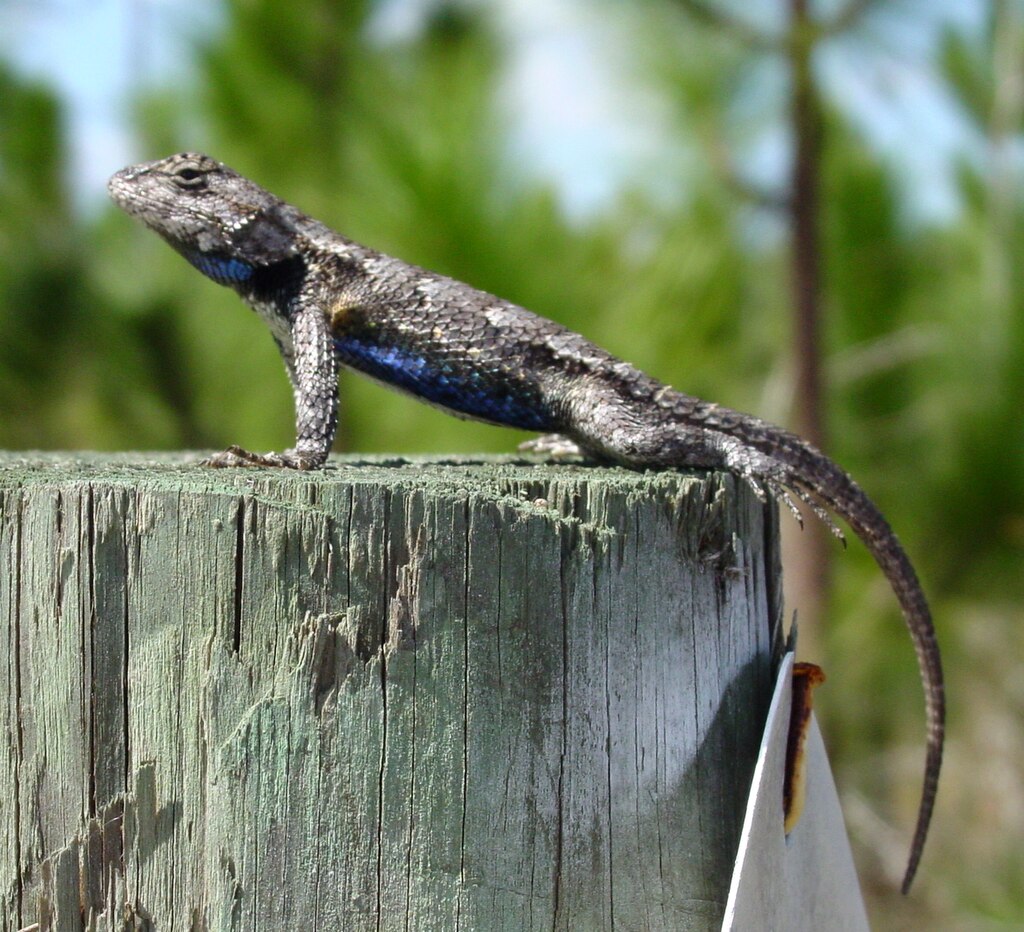
Scientific name: Sceloporus Undulatus.
Common name: Eastern fence lizard, prairie lizard, fence swift, gray lizard, northern fence lizard, pine lizard.
The eastern fence lizard grows up to 7.5 inches (19cm), including their tails. They are brown or gray in color with a dark line that runs down the back of their thigh.
Females are gray with dark wavy lines down her back. They have white tummies with black flecks, some have plate blue on the tummy and throat.
Male eastern fence lizards are brown and in summer they take on a green/blue color with black on their bellies and throats.
10. Coal Skink

Scientific name: Plestiodon Anthracinus.
Common name: Coal skink.
The coal skink can grow up to 7.1 inches (18cm) in total length. Their maximum snout to vent length is 2.8 inches (7cm).
These skinks have a dark lateral stripe that is around 4.5 scales in width without any lighter lines on the head. Males have red on the sides of their heads during mating season in the springtime.

You can find these skinks in hillsides, where there is plenty of loose stones and leaf litter. They are also found in rocky areas near creeks or springs. They will hide in shallow water if chased.
11. Mole Skink
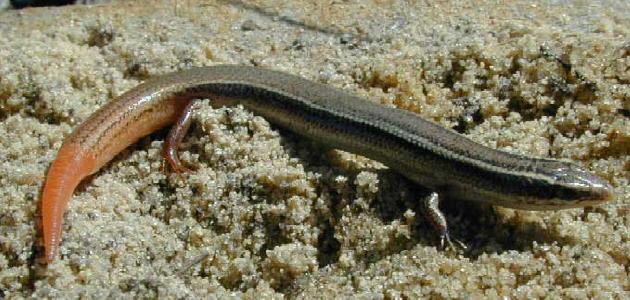
Scientific name: Plestiodon Egregius.
Common name: Mole skink.
These are not very common skinks in Alabama.
They are the only red-tailed skink in Alabama and can be found in coastal plains, ridges, and valleys.
They are burrowing lizards that are very seldom seen on the ground.
12. American Five-lined Skink
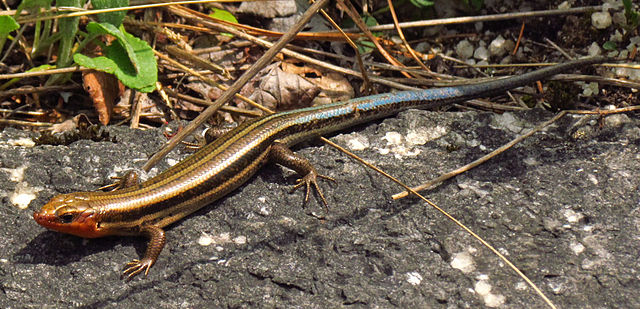
Scientific name: Plestiodon fasciatus.
Common name: American five-lined skink.
The American five-lined skink can grow up to 8.5 inches (21.5cm), including their tails.
Juveniles tend to be black to dark brown with five white to yellow stripes running down their bodies and bright blue tails. As they age, so does the blue on their tail, changing to a light blue with their stripes disappearing. Adults are uniformly brown.

These skinks can be found throughout most of the United States from Florida to Missouri and New York to Oklahoma, Texas, and Alabama.
These are ground-dwelling lizards that prefer a wooded habitat with ample cover. They can also be found in rocky areas.
13. Southeastern Five-lined Skink
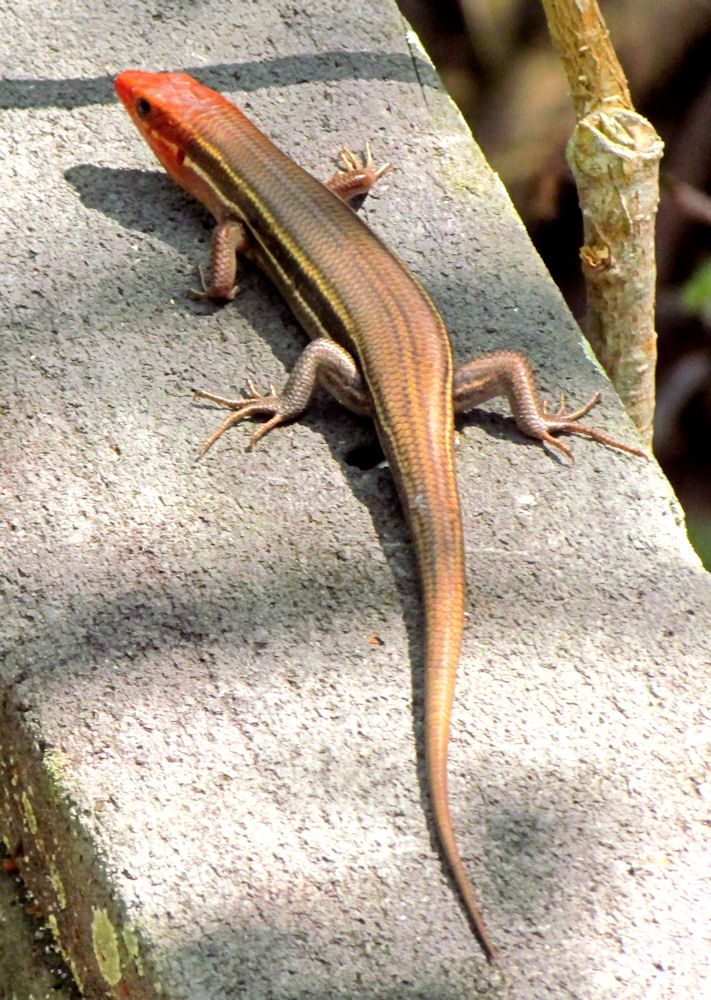
Scientific name: Plestiodon Inexpectatus.
Common name: Southeastern five-lined skink.
The southeastern five-lined skink has five narrow stripes along with their bodies, which eventually fade with age. The middle stripe tends to be narrower.
Younger skinks have black areas between the stripes, which fade to brown with age. Younger skinks have bright blue tails, turning a slight purple towards the tip. Stripes become red to orange near the head.
The orange red head can stay into adulthood, though the blue tail will fade.

These lizards prefer wooded areas and are often found where there is plenty of vegetation to hide in.
14. Broad-headed Skink

Scientific name: Plestiodon laticeps.
Common name: Broad-headed skink, broadhead skink.
This is the largest skink with a total length of 13.1 inches (33cm). These lizards have wide and powerful jaws, which gives their heads a triangular look.
Males are olive brown to brown in color with bright orange heads during mating season. Females have five light stripes down their back and tail.
Juveniles tend to be black to dark brown with stripes and bright blue tails, which fade as they age.

It’s not uncommon to find a broad-headed skink in an urban area, though they do prefer forest locations with plenty of leaf litter.
15. Little Brown Skink

Scientific name: Scincella lateralis.
Common name: Little brown skink, ground skink.
The little brown skink, also known as the ground skink, is one of the smallest reptiles you can find in North America.
It only grows to 5.5 inches (14.5cm) in total length, this includes the tail. They are copper brown in color with a white or yellow belly. They have an elongated body with short little legs.

These small skinks enjoy a host of habitats from forests to the edge of ponds and streams.
16. Six-lined Racerunner

Scientific name: Aspidoscelis Sexlineatus.
Common name: Six-lined racerunner.
This six-lined racerunner is brown, black, or dark green in color with six green to yellow stripes down the body that ranges from the head down to the tail.
The belly is white on females, though males tend to have a pale blue underside. Males are also known to have green throats. Their tail is twice their body length.
These are fast lizards reaching speeds of 18 miles per hour (29km/h). They’re dark for cover if you get too close to them. Their habitats range from rocky outcrops to woodlands, grasslands, and floodplains.
Texas horned lizard is often called the horned toad or horned frog. I played with this type of lizard when I lived in Arizona. They would make a hissing sound when they got mad at me. I was 9 years old, but I still remember these lizards, we called them Horny toads.